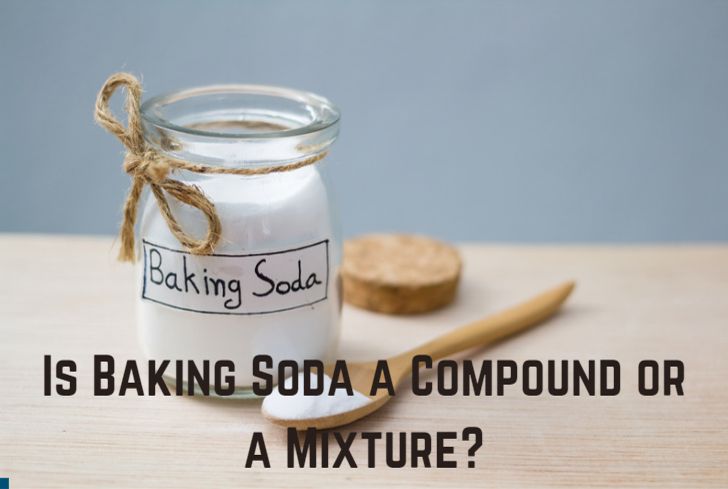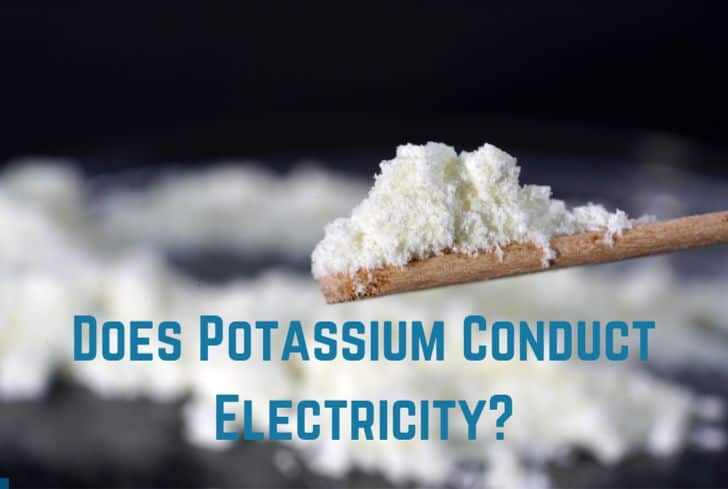Is Baking Soda a Compound or a Mixture? (Answered)

Baking soda or sodium bicarbonate is the common name for NaHCO3. It contains sodium (Na), hydrogen (H), carbon ( C ), and oxygen (O). Baking soda is mostly used for baking purposes and as a leavening agent to help raise your baked goods.
Baking soda has a lot of other uses as well, such as carpet stain remover, odor remover, pesticide, etc. However, some people might wonder – is baking soda a compound, or is it a mixture? Is it a homogeneous mixture or a heterogeneous one? These are a few questions that we will address in this article.
Read: Is Motor Oil Homogeneous or Heterogeneous?
Is Baking Soda a Compound or a Mixture?
Baking soda is a compound, where one molecule of sodium bicarbonate is the result of a combination of atoms of four elements. The four elements are sodium (Na), hydrogen (H), carbon ( C ), and oxygen (O). These four elements are bonded together and cannot be separated by simple physical means, hence it is considered a compound.
All of these atoms are chemically bonded together to form this compound called baking soda and they cannot be separated by a simple physical process. A mixture Is a substance that contains lots of elements that are mixed but can be separated. However, a compound is something where all the elements are bonded together into one single unit.
Baking soda is a white solid compound. As far as chemistry is concerned, a compound or baking soda is formed by the combination of all the different types of elements whose atoms are chemically bonded together in definite proportions.
Is Baking Soda a Pure Substance?
Baking soda is a pure substance and it contains only one type of compound which is Sodium Bicarbonate (NaHCO3). The combination of sodium, hydrogen, carbon, and oxygen molecules results in a single homogeneous substance called a pure substance.
Although there is a combination of different components, sodium bicarbonate is not a mixture because of its homogeneous properties. Baking soda is a by-product of sodium with hydrogen Oxygen and Carbon molecules which looks like a collection of white crystals.
Types of Compounds
There are two different types of compounds that are molecular or covalent compounds and ionic compounds. Both of these are described in detail below:
1. Covalent Compounds
A covalent compound is a compound that is the result of a covalent bond. Covalent compounds are the ones that are formed when atoms share one or more pairs of valence electrons. Gilbert N. Lewis, an American physical chemist first introduced the idea of covalent bonding in 1916.
Covalent compounds have atoms that are present in a specific ratio and this ratio remains the same in the entire substance. Covalent compounds are mostly known to contain carbon and hydrogen atoms which are termed organic compounds. The molecules present in this compound are all electrically neutral and they are not subject to dissociation when put in an aqua solution.
Some examples of covalent compounds are water, sucrose, DNA, etc.
2. Ionic Compounds
Ionic compounds are Crystalline solids that are the result of neatly packed ions of opposite charges. Normally when metals react with nonmetals ionic compounds are formed. Unlike covalent compounds, ionic compounds dissociate in water or when put in an aqua solution.
They are very good conductors of electricity and the ratio of atoms present in these compounds is definite. Research has found that most organic compounds are indeed ionic. In simple words, ionic compounds are compounds that are the result of ionic bonds.
When a reaction happens between metals and nonmetals the metals are the ones that generally lose electrons to complete their octet. However, the non-metals gain electrons to complete their octet. The result of these exchanges of electrons is the formation of an ionic compound.
Is Baking Soda a Heterogeneous Compound?
In a heterogeneous compound, the composition of the solution is not uniform throughout the mixture. In simple words, heterogeneous means a combination of dissimilar or diverse ingredients. Baking soda is not a heterogeneous compound because the molecules found in sodium bicarbonate are in a proper proportion throughout the mixture.
In a heterogeneous mixture, the atoms are not very well distributed or in an even proportion throughout the mixture. Normally the phases present in the heterogeneous mixture can be differentiated visually and they are not chemically bonded together. Unlike in a heterogeneous mixture, the components in baking soda cannot be separated by physical means.
Read: Is Black Coffee Homogeneous or Heterogeneous?
Is Baking Soda a Homogeneous Mixture?
Baking soda is a homogeneous mixture. A homogeneous mixture is a mixture where the proportions of its components are the same throughout. Homogeneous mixtures are uniform in their structure and composition. All the atoms present in a homogeneous mixture are uniformly distributed although they are not chemically combined.
Sodium bicarbonate or baking soda is a homogeneous mixture because the atoms present here are chemically bonded and they cannot be separated through any simple physical process. An example of a homogeneous solution is a mixture of salt and water.

Properties of Baking Soda
- Baking soda is non-flammable.
- Baking soda is not explosive.
- Baking soda has a melting point of 50 degrees Celsius and a boiling point of 851 degrees Celsius.
- Baking soda is a non-corrosive alkali.
- Baking soda has a molecular mass of 84.0066 g/mol.
- It exists in a powdery state with a monoclinic crystalline structure.
- The pH range of baking soda ranges between 8 and 9.
- Baking soda is an odorless substance.
- Baking soda is amphoteric which means it can behave both as an acid and base in an aqua solution.
Uses of Baking Soda
1. Baking
It is evident from the name baking soda that it is widely used in the baking industry. It is used as a leavening and it provides the necessary substance for the baked goods to rise. Baking soda works best in recipes that have acidic ingredients like buttermilk, lemon juice, etc. It is very useful in baking cakes, brownies, cookies, pancakes, etc.
2. Teeth Whitener
Researchers have found that toothpaste that contains baking soda is far better for whitening teeth than toothpaste that does not have baking soda. This is because it has slight abrasive properties that can break the bonds of molecules which stain our teeth. It is also known to have antibacterial and antimicrobial properties which might help in maintaining healthy gums.
3. Fridge odor neutralizer
If your fridge gives out a rotten odor that you cannot get rid of, then baking soda might be the answer. Baking soda can be used to freshen smelly fridges as it neutralizes bad odors. All you need to make this hack successful is to keep a cupful of baking soda at the end of your fridge, and the bad odor should vanish in a few days.
4. Whitening Agent For Clothes
Baking soda is one of the best ways to clean your clothes at a cheaper rate. It is an alkali and therefore can remove dirt and stains from clothes. When dissolved in water baking soda or sodium bicarbonate interacts with the acids and removes the stains. A spoonful of baking soda will work wonders when doing laundry.
Read: Is Steam a Mixture, Compound, or Pure Substance?
5. Carpet Stain Remover
Baking soda is also used to remove carpet stains when mixed with vinegar. The reaction between baking soda and vinegar creates a compound called carbonic acid which breaks down tough stains on the carpet. Spraying a simple mixture of a one-to-one ratio of each on the carpet can get the job done.
6. Pesticide
Are you a gardener who is tired of pesticide residue on your fruits and vegetables and are looking for a cheap way to remove them? Well, then baking soda will do this job for you. Although many people are concerned about its residue on food, baking soda does not harm the health of human beings, unlike other pesticides.
A baking soda bath can wash away impurities like pesticides from your fruits and vegetables without peeling them. This is one of the best ways to remove pesticides from your fruits and vegetables without the solution penetrating the fruit or vegetable’s skin.
Frequently Asked Questions
Does baking soda raise blood pressure?
Sodium bicarbonate might raise blood pressure. So, we would suggest people with already high pressure avoid baking soda.
Can I drink baking soda mixed with water every day?
Baking soda is a very good method of relieving temporary problems with digestion or heartburn. Research has found that baking soda or sodium bicarbonate may reduce muscle fatigue during athletic training. It is also very good for the gut and improves muscle endurance.
Can you lose weight with baking soda?
There is no scientific research supporting this fact and many people have faced the dangerous effects of ingesting baking soda in large amounts mixed with water. It is advised that baking soda should not be consumed unless a Health Care provider has suggested you do so.
Final Thoughts
Baking soda is a very important ingredient that we come across in our day-to-day life even though we don’t know that we are consuming it unknowingly.
It is considered a compound, not a mixture. It is also a homogeneous mixture and not a heterogeneous one. We hope that this article has answered all of your questions about the science of baking soda.





